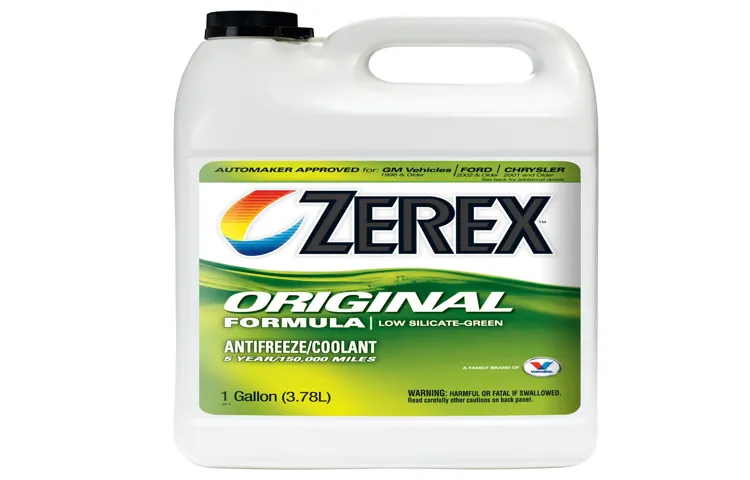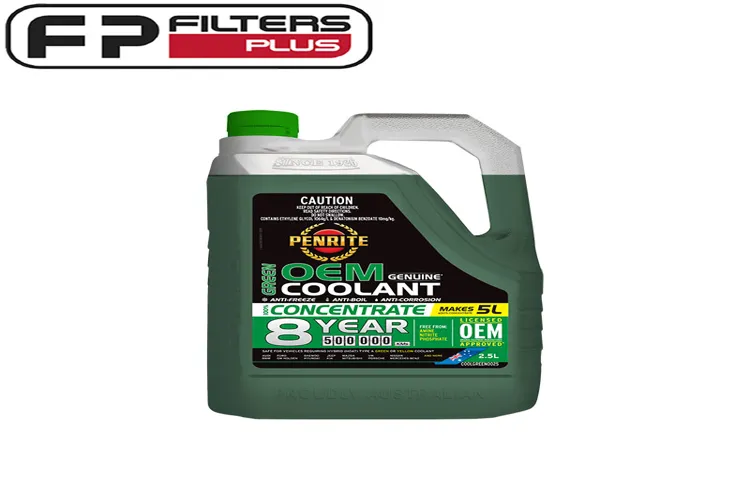If you’re no expert when it comes to cars or have only recently started taking an interest in engine maintenance, you’re likely wondering about what coolant to use in your vehicle. Perhaps you’ve noticed that most coolants available on the market come in a variety of colors, but which one is green? More importantly, does the green color signify anything significant? If you’ve found yourself in this predicament, fear not, as we’ve crafted this comprehensive guide to help you better understand what green coolant is and how it can benefit your engine. So sit back, and let us help you clear up the confusion once and for all!
Table of Contents
Introduction
When shopping for coolant for your car or other machinery, you may have noticed that some coolants come in a bright green color. This is commonly known as “green coolant” and is often made of a mixture of ethylene glycol and water. However, not all green coolants are created equal.
While some brands may use different additives and chemicals to enhance performance and longevity, others may use outdated formulas that can harm your engine. That’s why it’s important to do your research and choose a high-quality green coolant from a reputable brand. By selecting a coolant that meets your vehicle’s manufacturer specifications and maintaining it properly, you can ensure optimal performance and prevent costly engine damage.
So next time you’re in the market for coolant, remember to prioritize quality and choose the right green coolant for your needs.
Understanding Coolants
Coolants are essential fluids that are used in vehicles to regulate their temperature and prevent overheating. For many vehicle owners, understanding coolants and their purpose can be a bit confusing. To put it simply, coolants are substances that absorb the heat generated by the engine and help maintain its temperature at an optimal level.
They are made up of a mixture of water and chemicals, such as ethylene glycol or propylene glycol, that have a high boiling point and low freezing point. Coolants also play a significant role in preventing corrosion and providing lubrication to the engine’s components. By keeping the engine cool and lubricated, coolants ensure that your vehicle runs smoothly and efficiently.
As such, it is crucial to understand the different types of coolants available and choose the appropriate one for your vehicle to ensure maximum performance and longevity.

Types of Coolants Available
coolants Introduction: If you are into cars or any machinery that uses engines, then you understand the importance of coolants. Coolants play a crucial role in maintaining the right temperature for your engine. They also prevent your engine from overheating and decrease the risk of corrosion.
There are several types of coolants available in the market, each designed for a specific type of engine. In this blog post, we will explore the different types of coolants and their uses. Whether you are a newbie or a seasoned technician, this article will provide you with valuable insights into the world of coolants.
So, let’s get started!
Which Coolant is Green?
When it comes to coolants, many people associate green with the color of the fluid. So, which coolant is green? Typically, ethylene glycol-based antifreeze is green in color and widely used in modern cars today. This type of coolant is effective in protecting engines from freezing in cold temperatures and preventing overheating in hot weather.
However, it’s important to note that not all green coolants are the same. Some coolants may contain different types of additives that offer unique benefits such as improved corrosion resistance or longer life. It’s always best to follow your vehicle manufacturer’s recommendations when selecting a coolant, rather than solely relying on the color.
Maintaining the correct type and quantity of coolant can help ensure your engine runs smoothly and lasts longer.
Ethylene Glycol-Based Coolants
When it comes to coolants for your vehicle, there are a lot of options out there. But if you’re looking for a green coolant, the answer is ethylene glycol-based coolants. These coolants are not only better for the environment, but also provide better protection for your engine.
Ethylene glycol-based coolants are made with a non-toxic, biodegradable formula that is safe for both humans and animals. Plus, they are less likely to cause damage to your vehicle’s engine than other coolants. Additionally, these types of coolants help to reduce the amount of waste that goes into landfills.
So, if you want to be more environmentally friendly with your vehicle maintenance, consider using an ethylene glycol-based coolant.
Propylene Glycol-Based Coolants
When it comes to choosing a coolant for your vehicle, it’s important to know which ones are safe and efficient. Propylene glycol-based coolants are a popular choice because they are non-toxic and eco-friendly. Unlike their ethylene glycol counterparts, propylene glycol-based coolants are biodegradable and don’t harm the environment if they leak.
They also have a longer life span, requiring fewer coolant changes. But how do you know which one is green? Typically, propylene glycol-based coolants are green in color, making them easy to identify. It’s essential to check the label or consult a technician to ensure you’re buying the right product for your vehicle.
By using a green propylene glycol-based coolant, you can reduce your carbon footprint while keeping your car running efficiently.
Hybrid Coolants
When it comes to choosing the right coolant for your vehicle, hybrid coolants are gaining popularity for their eco-friendliness. These coolants are specifically designed to provide better engine performance while also reducing environmental impact. The main advantage of hybrid coolants is their ability to combine the benefits of both organic and inorganic coolants.
Organic coolants are made of biodegradable materials and are known to provide better corrosion protection, while inorganic coolants are effective in keeping engine parts clean and free of deposits. Hybrid coolants are a perfect blend of these two, offering long-lasting engine protection without harming the environment. Additionally, hybrid coolants significantly reduce the risk of coolant leakage, lowering the chance of engine failure and costly repairs.
Overall, if you are looking for an eco-friendly and efficient coolant for your vehicle, hybrid coolants are the way to go.
Factors to Consider When Choosing Green Coolants
When considering which coolant is green, there are several factors to keep in mind. First, it’s important to look for coolants that are free from harmful chemicals such as ethylene glycol and propylene glycol. These chemicals can be harmful to the environment and can lead to pollution and toxicity in waterways.
Instead, look for coolants that are made from renewable sources and are biodegradable. Secondly, it’s important to choose a coolant that is effective and reliable. Green coolants should still provide sufficient heat transfer and protection against corrosion and rust.
Lastly, consider the cost and availability of the coolant. While green coolants can be more expensive than traditional options, they may be worth the investment in the long run for their environmental benefits. Ultimately, selecting a green coolant requires finding a balance between efficiency, reliability, and sustainability.
Vehicle Compatibility
When it comes to choosing green coolants for your vehicle, there are several factors to consider. The first and most important is compatibility. Not all green coolants are suitable for every type of vehicle.
You will need to make sure that the green coolant you choose is compatible with the make and model of your car. This is especially important if you have a modern car with a complex cooling system. You will want to check the manufacturer’s recommendations for the type of coolant to use in your vehicle.
Another factor to consider is the operating temperature range of the green coolant. If you live in an area with extreme temperatures, you will need a coolant that can withstand these conditions without breaking down. Lastly, you’ll want to ensure that your green coolant will last for the recommended amount of time before needing to be changed.
By taking these factors into consideration, you can select the right green coolant to keep your vehicle running smoothly, while also being environmentally-friendly.
Environmental Considerations
Green coolants are an excellent alternative to traditional coolants that can have adverse environmental impacts. When considering green coolants, there are several factors to keep in mind. First, it’s essential to check the coolant’s biodegradability.
Biodegradable coolants are more environmentally friendly than non-biodegradable ones since they break down into harmless compounds over time. Second, look at the coolant’s composition. Organic coolants are typically better than inorganic ones, as they typically do not contain harmful chemicals.
Another important factor to consider is the production process. The production method of green coolants should be less harmful to the environment and not contribute to global warming. Also, production needs to be energy-efficient with less waste production.
Finally, consider how the coolant is disposed of because some coolant types are hazardous or non-recyclable and can cause harm to the environment. Look for coolants that come with a disposal protocol to ensure that their disposal does not harm the surrounding. In conclusion, green coolants are the responsible choice when it comes to environmental considerations.
They are biodegradable, environmentally friendly, and energy-efficient. Before selecting a green coolant, make sure to check its composition, production method, and disposal protocol. Remember, choosing a green coolant can protect the environment and also benefit your equipment’s longevity, ensuring less damage to both the environment and the machinery.
Conclusion
In conclusion, the answer to the age-old question of which coolant is green is simple: the one that is, well, green! But beyond its vibrant hue, green coolant actually serves an important purpose in keeping engines cool and operating at optimal levels. Just remember, when it comes to coolants, green is not just a color, it’s a crucial component in maintaining the health and performance of your vehicle. So next time you pop the hood, make sure your green coolant is flowing smoothly, and you’ll be good to go!”
FAQs
1. What is the significance of the green color of coolant? Ans: The green color of coolant indicates that it is an ethylene glycol or propylene glycol-based coolant. 2. Can I use any green coolant in my vehicle? Ans: No, you must use the coolant that is recommended by the manufacturer of your vehicle. 3. What is the difference between ethylene glycol-based green coolant and propylene glycol-based green coolant? Ans: Ethylene glycol-based green coolant is more toxic and has a longer service life as compared to propylene glycol-based green coolant. 4. How often should I replace the green coolant in my vehicle? Ans: The replacement interval varies among different vehicle manufacturers and models. Refer to the owner’s manual for specific information. 5. What happens if I mix different types of green coolant? Ans: Incompatibility issues may arise, leading to reduced coolant performance and even damage to the engine. 6. Can I use green coolant in extreme temperatures? Ans: Yes, green coolants are designed to provide protection in both hot and cold temperatures. 7. How can I tell if the green coolant in my vehicle needs to be replaced? Ans: Check the color and consistency of the coolant. If it appears dirty or rusty, it’s time to replace it.


